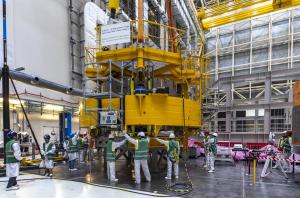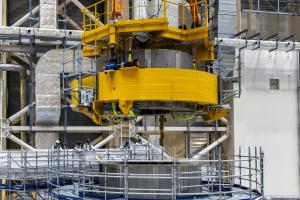Like grasping a bowl of cereal
Contrary to the vast majority of ITER machine components, the modules that form the central solenoid cannot be lifted by way of hooks and attachments. The 110-tonne cylindrical components provide no space for a robust structure for the bolting or welding of lift devices; instead, a central solenoid module needs to be handled like one would grasp a giant bowl of cereal, by exerting pressure from the outside.
A bowl of cereal can be grasped and moved with two hands. A central solenoid module requires nine powerful wedge pads located at the bottom of a lifting fixture, each one exerting a radial force of 220 kN (equivalent to 22 tf (tonne-force)) on nine friction pads distributed around the cylinder.
Designed and manufactured by US ITER, who procures the central solenoid, the system has once again proved its efficiency. On Thursday 11 April, the third module was successfully lifted and positioned with a slight radial offset on top of the existing two-module stack. The 325-millimetre offset provides room for equipment and connection work to be completed before the module gets positioned in its final location, aligned on the central solenoid axis.



